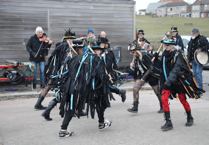I CAUGHT a lift to Pounda so I could take a look at the hedgerows as I walked the mile or so back to the village.
First things I saw were literally thousands of Navelwort leaves on the hedges that made me think that 2024 must be National Navelwort Year.
Growing in clusters with some of the dimpled leaves, hence their name; Navel, up to 6cm wide. The plants occasionally send up a tall stem with pendulous yellowish-green flowers.
They sometimes grow on the joints of stone walls, giving them the alternative name, Wall Pennywort.
Scurvy grass plants are also showing their leaves and these were a lifesaver for sailors during the 17th century when they were eaten raw on board ship, in order to ward off scurvy.
Their second name; grass, is a misnomer as they are members of the Cabbage family and are not grass at all.
A robin flew from branch to branch and kept pace with me as I walked down to the mill.
Robins are very friendly birds and if I get one in the garden and offer it food – they love dried mealworms – it will come quite close as I place the worms on the saucer.
The robin is ever hopeful and always in viewing distance of his saucer when I go nearby.
One bird I will never get close to is a bullfinch, and it’s useless to try. There was a male down near the stream feeding on something that I couldn’t identify.
These birds are once seen, never forgotten with their thick ‘bull’ neck and beautiful rose-pink chests, but unfortunately, they are becoming very scarce.
However, for those that are still around, spring is the best time of the year for them as their main source of food is buds on trees, especially fruit trees.
They were hated by apple and cherry farmers who would obviously lose part, or sometimes most, of their crops to bullfinches.
A good part of the road back from Trehunist is bordered by brambles that grow along the bottom of the hedge and, as usual, I was walking very slowly looking into the hedge creep all the time when I spotted some Candle snuff or Stag’s horn fungus growing on some dead, buried wood.
The white, delicate fungus was around 5cm tall and can be seen all year round, but if you go looking for it you must keep your eyes on the hedge all the time.
On the other end of the size scale, near a farm entrance, I saw an Inonotus dryadeus, or what is usually called the Oak fungi on a tree.
This is a bracket fungus that grows on broad- leaved trees and can reach 65cm, that’s over 25 inches across. It can be seen all year round.
I came across a group of four crocuses that stood out well on the hedge.
I wondered how long ago they had been planted there and I hoped that nobody would dig up these beautiful flowers, thinking they would look better in their garden at home.




